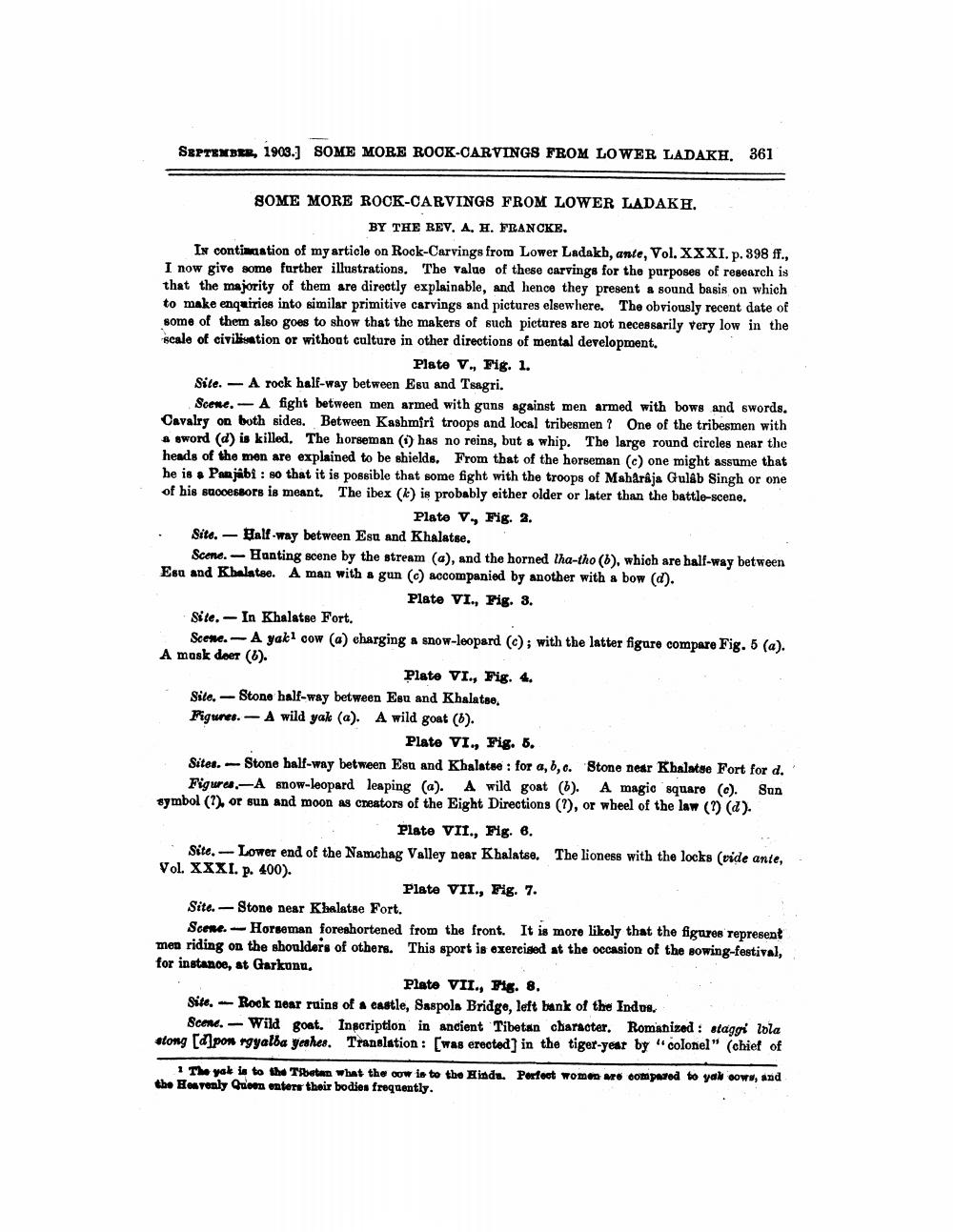________________
SEPTEMBER, 1903.] SOME MORE ROCK-CARVINGS FROM LOWER LADAKH, 361
SOME MORE ROCK-CARVINGS FROM LOWER LADAKH.
BY THE REV. A. H. FRANCKE.
In continuation of my article on Rock-Carvings from Lower Ladakh, ante, Vol. XXXI. p. 398 ff., I now give some further illustrations. The value of these carvings for the purposes of research is that the majority of them are directly explainable, and hence they present a sound basis on which to make enquiries into similar primitive carvings and pictures elsewhere. The obviously recent date of some of them also goes to show that the makers of such pictures are not necessarily very low in the scale of civilisation or without culture in other directions of mental development.
Plate V., Fig. 1. A rock half-way between Esu and Tsagri.
Site.
Scene. A fight between men armed with guns against men armed with bows and swords. Cavalry on both sides. Between Kashmiri troops and local tribesmen? One of the tribesmen with a sword (d) is killed. The horseman (1) has no reins, but a whip. The large round circles near the heads of the men are explained to be shields. From that of the horseman (c) one might assume that he is a Panjabi: so that it is possible that some fight with the troops of Maharaja Gulab Singh or one of his successors is meant. The ibex (k) is probably either older or later than the battle-scene.
Plate V., Fig. 2.
Half-way between Esu and Khalatse.
Site. Scene. Hunting scene by the stream (a), and the horned tha-tho (b), which are half-way between Esu and Khalatse. A man with a gun (c) accompanied by another with a bow (d).
Plate VI., Fig. 3.
Site. In Khalatse Fort.
Scene. A yak1 cow (a) charging a snow-leopard (c); with the latter figure compare Fig. 5 (a). A mask deer (6).
Plate VI., Fig. 4. Site.Stone half-way between Esu and Khalatse, Figures. A wild yak (a). A wild goat (b).
Plate VI., Fig. 5. Sites. Stone half-way between Esu and Khalatee: for a, b, c. Stone near Khalatse Fort for d. Figures. A snow-leopard leaping (a). A wild goat (b). A magic square (e). Sun symbol (?), or sun and moon as creators of the Eight Directions (?), or wheel of the law (?) (d).
Plate VII., Fig. 6.
Site. Lower end of the Namchag Valley near Khalatse. The lioness with the locks (vide ante, Vol. XXXI. p. 400).
Plate VII., Fig. 7.
Site. Stone near Khalatse Fort.
Scene. Horseman foreshortened
from the front. It is more likely that the figures represent men riding on the shoulders of others. This sport is exercised at the occasion of the sowing-festival, for instance, at Garkunu.
Plate VII., Fig. 8.
Rock near ruins of a castle, Saspola Bridge, left bank of the Indus.
Site. Scene. Wild goat. Inscription in ancient Tibetan character. Romanized: staggi lola stong [dpon rgyalba yeshes. Translation: [was erected] in the tiger-year by "colonel" (chief of
1 The yak is to the Tibetan what the cow is to the Hinda. Perfect women are compared to yak sows, and the Heavenly Queen enters their bodies frequently.




